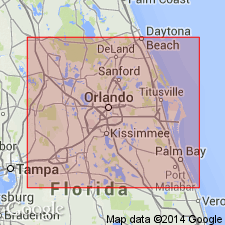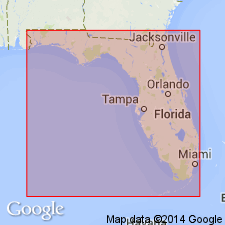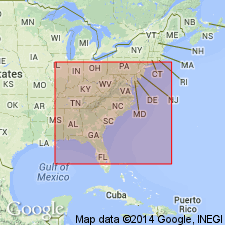
- Usage in publication:
-
- Osceola Granite
- Modifications:
-
- First used
- Dominant lithology:
-
- Granite
- Granodiorite
- AAPG geologic province:
-
- South Florida province
Summary:
Osceola Granite represents major lithotectonic element in pre-Cretaceous crystalline basement of peninsular FL. Unit is similar in age and petrographic character to Coyah Granite of West Africa, which suggests that they were once part of same sequence that was emplaced along northwest margin of Gondwana continent. Pluton is heterogeneous and consists predominantly of biotite granodiorite, leucocratic biotite quartz monzonite and/or biotite granite. Most samples examined in this study composed of oligoclase, quartz, perthitic alkali feldspar, and biotite. Appears to have been emplaced at shallow crustal levels and to have cooled rapidly. Cambrian age based on isotopic dates of 527.4+/-1.9 and 534.6+/-2.0 Ma.
Source: GNU records (USGS DDS-6; Reston GNULEX).

- Usage in publication:
-
- Osceola Granite
- Modifications:
-
- Named
- Dominant lithology:
-
- Granite
- Alaskite
- Quartz monzonite
- AAPG geologic province:
-
- South Florida province
Summary:
Osceola Granite, part of the Suwannee terrane, occupies a rectangular area in central FL. Rocks are classified as granite, alaskite, and quartz monzonite based on examination and are therefore true igneous rocks rather than granite gneisses. Rb-Sr dating (Bass, 1969: AAPG Memoir 11, p. 283-310) suggests age of at least 530 Ma. Authors state, "No formal stratigraphic nomenclature has been defined for rocks of the Suwannee terrane and no single well or group of wells has penetrated a sufficient thickness of beds for clear definition of stratigraphic sequence or contacts. Nevertheless, a general stratigraphic sequence can be compiled." . [This is not a formal proposal, but is cited as the naming paper by various authors who use this nomenclature. See also Plate 6, this volume.]
Source: GNU records (USGS DDS-6; Reston GNULEX).

- Usage in publication:
-
- Osceola Granite*
- Modifications:
-
- Overview
- AAPG geologic province:
-
- South Florida province
Summary:
Osceola Granite (of Thomas and others, 1989) mapped in east-central FL where it constitutes a large part of the pre-Mesozoic crystalline basement. Description and age information taken from Dallmeyer and others (1987).
Source: GNU records (USGS DDS-6; Reston GNULEX).
For more information, please contact Nancy Stamm, Geologic Names Committee Secretary.
Asterisk (*) indicates published by U.S. Geological Survey authors.
"No current usage" (†) implies that a name has been abandoned or has fallen into disuse. Former usage and, if known, replacement name given in parentheses ( ).
Slash (/) indicates name conflicts with nomenclatural guidelines (CSN, 1933; ACSN, 1961, 1970; NACSN, 1983, 2005, 2021). May be explained within brackets ([ ]).

